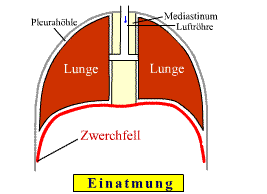Abdominal breathing
The abdominal breathing ( abdominal breathing ) or diaphragmatic breathing ( Diaphragmalatmung ) is a normal, quiet type of lung ventilation ( ventilation ). The type of breathing, which is more dominated by movements of the chest, is called chest breathing .
In abdominal breathing, inhalation occurs through the contraction (contraction) of the diaphragm , which increases the negative pressure in the pleural space . Following this negative pressure, the lungs are expanded and air is sucked in. With this breathing technique, exhaling takes place by relaxing the diaphragm, which causes the lungs to contract due to their own elasticity and “squeeze out” the air. Exhalation can be deliberately supported by tensing the abdominal muscles .
This form of breathing is used unconsciously when the human body is relaxed, for example when sitting or sleeping, as well as by small children and the elderly. Abdominal breathing is consciously used by good singers and brass musicians as a breath support and as an important component in many Asian martial arts. Because only a small proportion of the respiratory muscles are active, less energy is consumed than with chest breathing. The blood pressure is lowered and digestion is aided by massaging the intestines . In addition, the negative pressure in the abdominal cavity promotes the venous return flow, as this pressure gradient continues down to the inferior vena cava ( inferior vena cava ), which opens into the right atrium of the heart.
